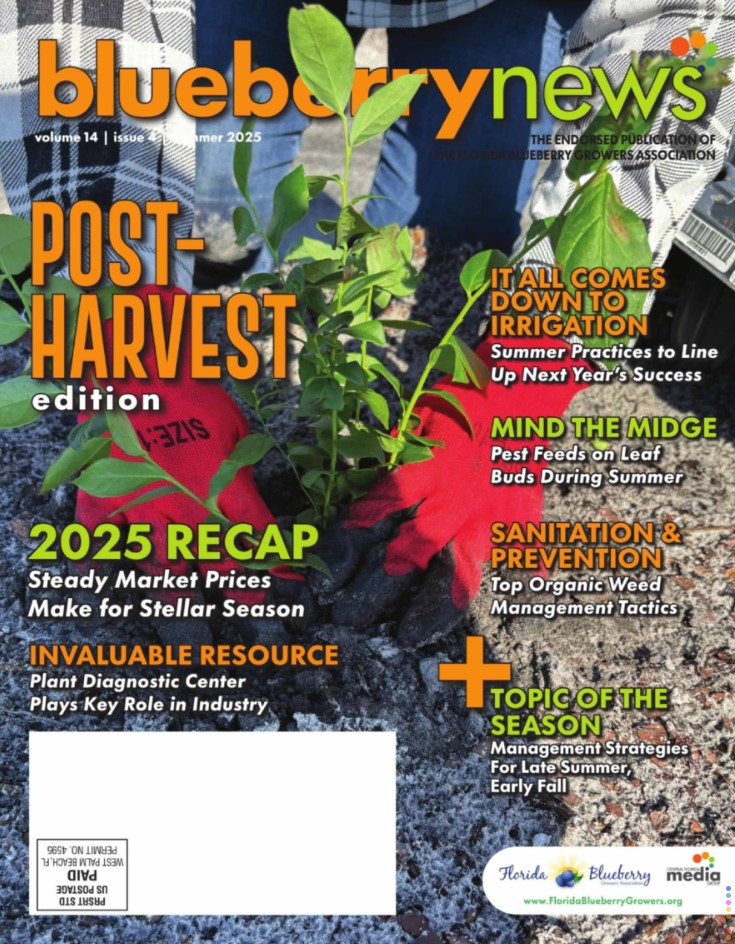Florida blueberry growers produce more berries this year, despite pollination problems, gall midge and Hurricane Irma.
Large blooms held promise for a bumper blueberry crop this year. But environmental problems, including pollination, gall midge and Hurricane Irma, made a significant dent. In all, some 20 million pounds of blueberries were picked statewide, up from about $19 million last year, according to Brittany Lee, president of the Florida Blueberry Growers Association.
“Some growers had wonderful yields, what they were expecting. Others lost between 20-70 percent production,” she says. “It was really site specific.”
Yields were about 30 percent less than anticipated overall, she says.
“Everyone expected the volume in Florida to be so high,” says Kyle Hill, farm manager of Southern Hill Farms south of Clermont and owner of H & C Harvesting, a mechanical harvesting firm. “It was much lower than expected.”
Hill launched the mechanical harvesting company this year. “Not all growers are on board,” he acknowledges. “The ones that are really have benefited from it.”
The key to success with it is using the right varieties, such as Farthing, Meadow Lark, and Emerald, and training the bushes for the harvester early. “You want to have a skinny base to where the fruit that comes off the bush doesn’t come through the cracks,” he explains.
He’s able to achieve pack-out rates of between 86 and 93 percent, with 93 percent approximating the hand-picking rate. They typically harvest every six days, charging a per pound rate.
Hill advises customers to put half-gallon orange cartons over the blueberry plants when they are put into the ground to make sure they grow straight. When this isn’t done, a grower can lose more berries during harvesting.
Kyle’s brother, Michael Hill, reports blueberries brought in $4.50 a pound. “If you can’t make money doing that, you’re not dong something right,” says Michael, general manager/owner of H & A Farms, a packinghouse that distributed about four millions pounds of fruit this year.
Conventional blueberry shipments rose 2.7 percent in 2018, according to Dan Sleep, Bureau Chief of Strategic Development at the Florida Department of Agriculture and Consumer Services’ Division of Marketing and Development. There were 477 40,000-pound truckloads in 2017, compared to 490 this year. On the organic side, truckloads were down from 16 to 14 this year.
Florida’s blueberry crop had an average value of $71 million between 2010 and 2016, according to the bureau’s Florida Crop Highlight – Blueberries report issued in April. In the latest year listed in the report, 2016, the crop’s value was $53.7 million, earning it a ranking of 11th in market share nationwide. The total economic impact was $139.4 million.
Bobby Barben, owner/manager at Barben Farms in the Avon Park area, says blueberry growers were hit with a “perfect storm” this year: gall midge, pollination, and hurricane. His production was 35 percent less than expected. “We did not have a good crop on Kestrel,” he says. “Emerald and Jewel for us did pretty well this year.”
Kestrel was hit the hardest, with 75 to 80 percent loss; Meadow Lark and Farthing suffered a 50-percent loss. He believes Meadow Lark and Farthing were affected by gall midge. Jewel and Emerald had minimal damage, at only 5 to 10 percent.
Growers were trying different things like hoophouses, with the goal of higher yields, higher densities and organic growing. While it was early to say much about how the hoophouses worked, Chuck Allison reports success with drip irrigation.
“We feel like the utilization of drip irrigation and fertigation -- with soil moisture probes ... -- helped us to increase our productivity and yields,” says Allison, owner of Wild Goose Farms in Umatilla, which has some 120 acres of blueberries.
Estimating the crop incorrectly was a problem, Barben says. “Florida and Georgia both have to do a better job of crop estimates going forward,” he adds.
That is an issue FBGA has been working on. “We are currently waiting on [grant] approval from the USDA. We have been steadily making progress on this for several years and look forward to the market stability that having an accurate forecast will afford our growers,” Lee says.
The FBGA also is developing plans for its fall meeting, with time and date to be determined.
In May, the organization spoke out against the “competitive disadvantage” it faces with low-cost fruit. Together with the Georgia Blueberry Growers Association, the growers wrote to their Congressmen asking that the industry be protected in North American Free Trade Agreement (NAFTA) negotiations.
“The massive importation of Mexican blueberries during our window are crippling the Florida and Georgia Blueberry Industries,” the letter states. “Mexico realizes many cost savings benefits, including but not limited to, lower growing and labor costs, that puts Florida producers at a competitive disadvantage. To add insult to injury, a USDA variety (Biloxi) paid for by U.S. tax dollars at no cost to Mexican growers is the most widely planted variety.”
The letter was signed by Lee and Brandon Wade, president of the GBGA.
“We applaud the Administration’s commitment to a renegotiation with Mexico and Canada,” it says. “The viability of our industry is at stake.”
According to USDA figures, Florida shipped 19.61 million in conventional blueberries through June 2 this year, compared with some $19.07 million through June 3 last year. Mexico shipped 53.68 million through June 2, up from 45.27 million by June 3 last year. The total volume from Mexico last year was 46.85 million.
By CHERYL ROGERS
[/fusion_builder_column][/fusion_builder_row][/fusion_builder_container]





